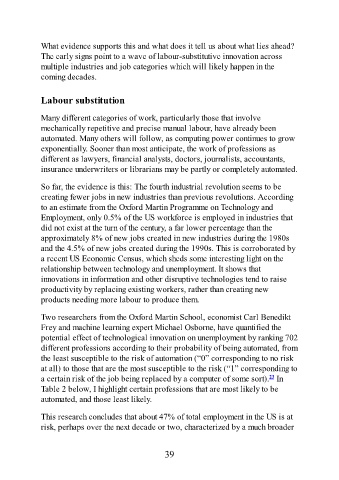Page 39 - The Fourth Industrial Revolution
P. 39
What evidence supports this and what does it tell us about what lies ahead?
The early signs point to a wave of labour-substitutive innovation across
multiple industries and job categories which will likely happen in the
coming decades.
Labour substitution
Many different categories of work, particularly those that involve
mechanically repetitive and precise manual labour, have already been
automated. Many others will follow, as computing power continues to grow
exponentially. Sooner than most anticipate, the work of professions as
different as lawyers, financial analysts, doctors, journalists, accountants,
insurance underwriters or librarians may be partly or completely automated.
So far, the evidence is this: The fourth industrial revolution seems to be
creating fewer jobs in new industries than previous revolutions. According
to an estimate from the Oxford Martin Programme on Technology and
Employment, only 0.5% of the US workforce is employed in industries that
did not exist at the turn of the century, a far lower percentage than the
approximately 8% of new jobs created in new industries during the 1980s
and the 4.5% of new jobs created during the 1990s. This is corroborated by
a recent US Economic Census, which sheds some interesting light on the
relationship between technology and unemployment. It shows that
innovations in information and other disruptive technologies tend to raise
productivity by replacing existing workers, rather than creating new
products needing more labour to produce them.
Two researchers from the Oxford Martin School, economist Carl Benedikt
Frey and machine learning expert Michael Osborne, have quantified the
potential effect of technological innovation on unemployment by ranking 702
different professions according to their probability of being automated, from
the least susceptible to the risk of automation (“0” corresponding to no risk
at all) to those that are the most susceptible to the risk (“1” corresponding to
23
a certain risk of the job being replaced by a computer of some sort). In
Table 2 below, I highlight certain professions that are most likely to be
automated, and those least likely.
This research concludes that about 47% of total employment in the US is at
risk, perhaps over the next decade or two, characterized by a much broader
39

